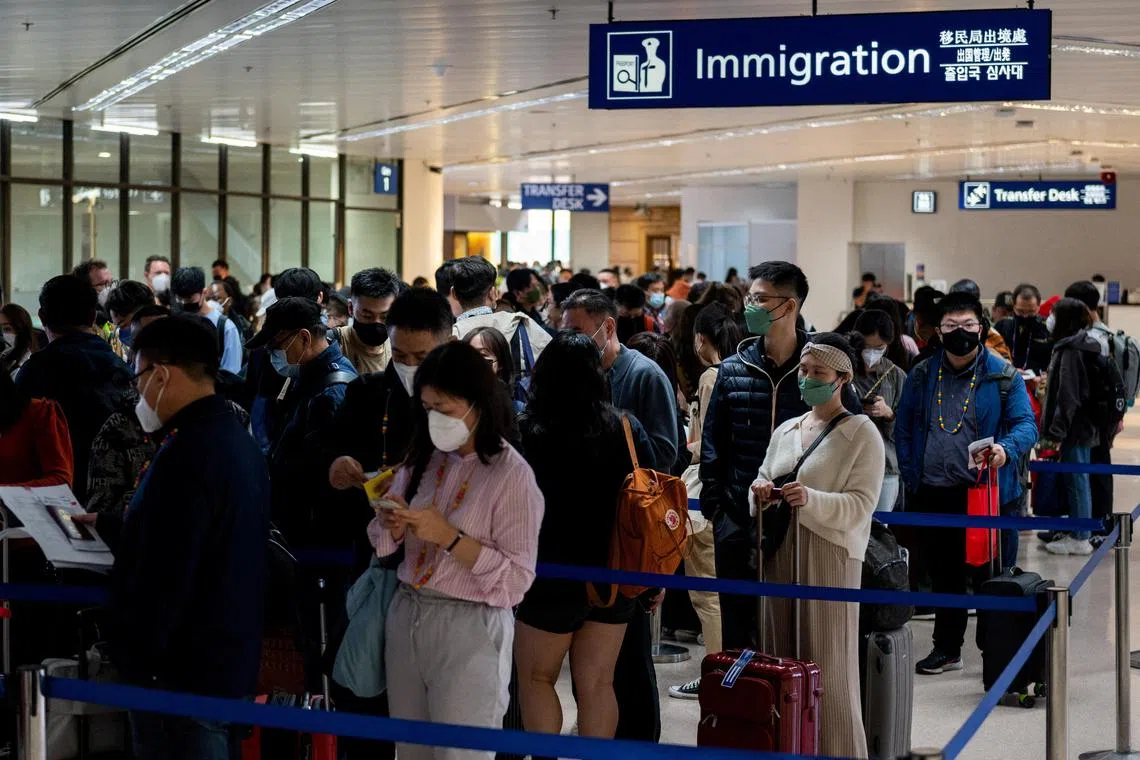China to issue visas, reopen borders to foreign tourists for first time since 2020
Sign up now: Get ST's newsletters delivered to your inbox

The updated policy will allow for the resumption of visa-free travel for those arriving in cruise ships at Shanghai, as well as for certain tourist groups from Hong Kong, Macau and Asean.
PHOTO: REUTERS
Follow topic:
BEIJING – China will once again start issuing a range of visas to foreigners as of Wednesday, the country’s Foreign Ministry said, in a major easing of travel restrictions
The move marks the latest step towards reopening China to the outside world, as Beijing gradually breaks with the strict zero-Covid strategy
In addition to new visas being reviewed and approved, those issued before March 28, 2020, that remain valid will once again allow entry to China, said a notice posted on Tuesday on a social media account affiliated with the Foreign Ministry’s consular affairs bureau.
Similar notices appeared on the websites of several overseas Chinese missions, including the country’s embassies in the United States and France.
The updated policy will also allow the resumption of visa-free travel for those arriving in cruise ships at Shanghai, as well as for certain tourist groups from Hong Kong, Macau and countries within the Asean regional grouping, the notice said.
The move would “further facilitate the exchange of Chinese and foreign personnel”, it added.
China received 65.7 million international visitors in 2019, according to data from the United Nations World Tourism Organisation, before sealing itself off from the rest of the world during the pandemic.
While most other countries began fully reopening their economies and welcoming international travellers earlier, China began emerging from its strict Covid-19 containment policies only in late 2022, after rare demonstrations against President Xi Jinping’s signature zero-Covid strategy broke out across the country.
Those protests in late November expanded into calls for more political freedoms, with some even calling for Mr Xi to resign, turning into the most widespread opposition to communist rule since the 1989 Tiananmen Square uprising.
Abrupt reversal
Early last December, the Chinese authorities effectively ended the regime of mass testing, lockdowns and long quarantines – but the abrupt reversal led to a sudden spike in Covid-19 cases.
Beijing announced in late December that from Jan 8, inbound travellers to the country would no longer need to quarantine, but kept in place visa restrictions on foreigners.
At the time, Beijing said it would “continue to adjust its visa policy for foreigners visiting China in a scientific and dynamic manner in accordance with... the epidemic situation”.
It also then resumed issuing Chinese passports for “tourism” or “overseas visits of friends”.
With cases surging in China around the start of 2023, restrictions on Chinese visitors,
As cases waned in China, both sides subsequently eased those restrictions.
The announcement that China will resume issuing visas to foreigners comes as the country’s rubber-stamp Parliament wrapped up an important session in Beijing, during which Mr Xi was confirmed for a third term as president Li Qiang became premier.
Mr Li on Monday admitted that achieving the country’s economic growth target of “around 5 per cent” would be “no easy task”.
China posted a growth of just 3 per cent growth in 2022,

